
The Euphrates River stretches 1,740 Miles
©Sadik Yalcin/Shutterstock.com
The Euphrates River is one of Western Asia’s historical gems, stretching 1,740 miles. The river is of economic importance and is a prominent feature in many cultural and religious tales important to Asians. The Euphrates River often flowed as a boundary between kingdoms and was where they would meet and battle.
Some sources claim that the river’s drainage basin, an area of about 193,051 square miles (500,000 square kilometers), is distributed among 5 countries. Iraq has the largest share with about 47%, Turkey takes about 28%, and Syria 22%. Jordan and Saudi Arabia have small shares with 0.03% and 2.97% each.
Consequently, the Euphrates River has many snakes native to these locations in and around it. Here are 12 snakes of the Euphrates River and its surrounding basin.
1. Levantine Viper

Levantine vipers can be identified by their brown, gray, beige, or olive coloring.
©Vladislav T. Jirousek/Shutterstock.com
The Levantine viper is a large and venomous viper found in many parts of the Middle East and Northern Africa. These snakes can grow as long as 59.1 inches (4.9 feet), with females typically longer than males. However, their sizes generally depend on where they are situated.
They are often found in dry and rocky areas and on farms in mountainous areas.
The Levantine viper’s unique and dangerous venom is one added reason for reinforced calls to abandon the term “Big 4” in reference to India’s deadly species.
Currently, there is no anti-venom for the bite of the Levantine viper. However, some people luckily survive its bites. These vipers can be identified by their brown, gray, beige, or olive coloring.
2. Desert Horned Viper
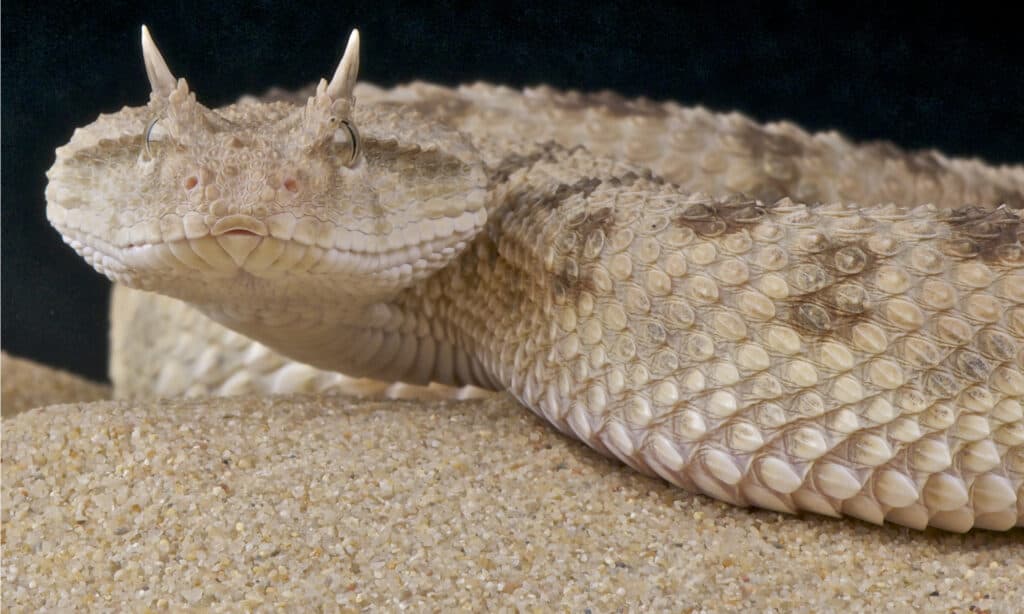
The desert horned viper emits anywhere from 19 to 100 mg of venom.
©reptiles4all/Shutterstock.com
Also known as the Saharan viper, the desert horned viper is found in scrub brushes, sandy desert areas, and rocky outcroppings. The desert horned viper is an extremely venomous snake, emitting anywhere from 19 to 100mg of venom and needing only about 40–50 mg to kill a human. They are usually about 12–24 inches (1-2 feet) in length.
3. Persian Sand Viper
The Persian sand viper is often referred to as the Persian horned viper and is found in flat rocky or sandy desert areas. It grows to an average length of 16 to 28 inches (1.3 to 2.3 feet) and is known for its slow movements.
However, despite their seemingly slow sidewinding movements, they are quick to strike. Persian sand vipers also hiss aggressively when humans approach.
4. Radde’s Rock Viper
Radde’s rock vipers are found in many middle eastern countries but are native to Armenia. They are the only one of the four Armenian vipers not classified as Near Threatened or Critically Endangered. The species is moderately venomous, and fatalities from its bites are rare but possible.
They are known to attain a maximum length of 39 inches and are found in farmlands and rocky areas. Radde’s rock vipers come in a variety of colors which include grayish-brown, grayish-black, or orange-spotted black.
5. Desert Black Snake
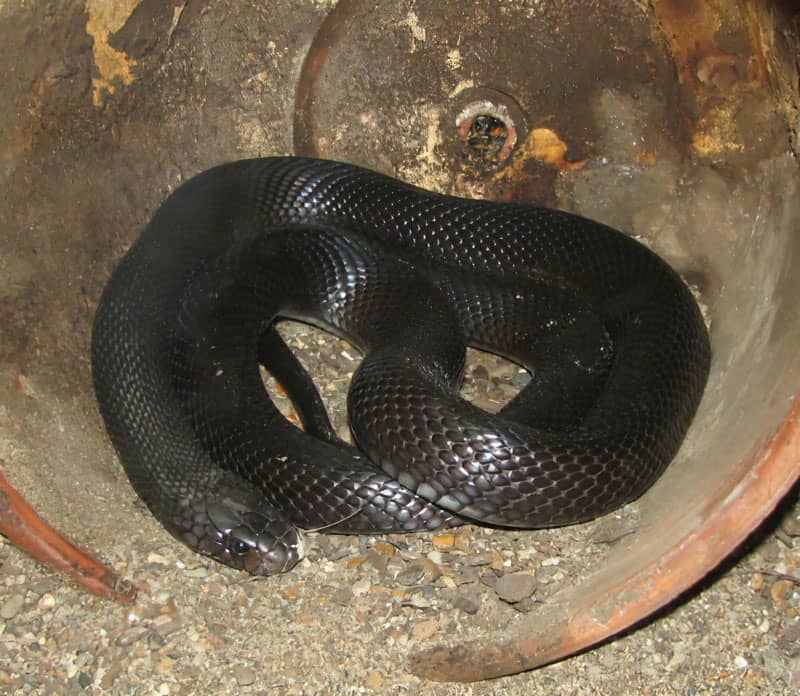
The desert black snake is completely black with shiny scales.
©Ltshears / public domain – License
Desert black snakes are highly venomous pit vipers found in sandy deserts, irrigated fields, and barren and rocky mountain hillsides.
Also known as the desert cobra, this snake species falls under the elapid family and is fully black with shiny scales. Their venom has a lethal dose of 0.18mg/ pound (0.4 mg/kg) and is extremely similar to the king cobra‘s venom.
6. Arabian Gulf Sea Snake
The Arabian Gulf sea snake is an elapid snake found in the Arabian Sea, the Gulf of Oman, and the Persian Gulf. It is often called the Persian Gulf sea snake and is known to attain 43 inches (3.6 feet) in length.
Its venom contains neurotoxins that affect the nervous system, brains, nerves, heart, and breathing rates. The Arabian Gulf sea snake can be identified by its yellow, gray, or olive body with black or olive bands.
7. Beaked Sea Snake
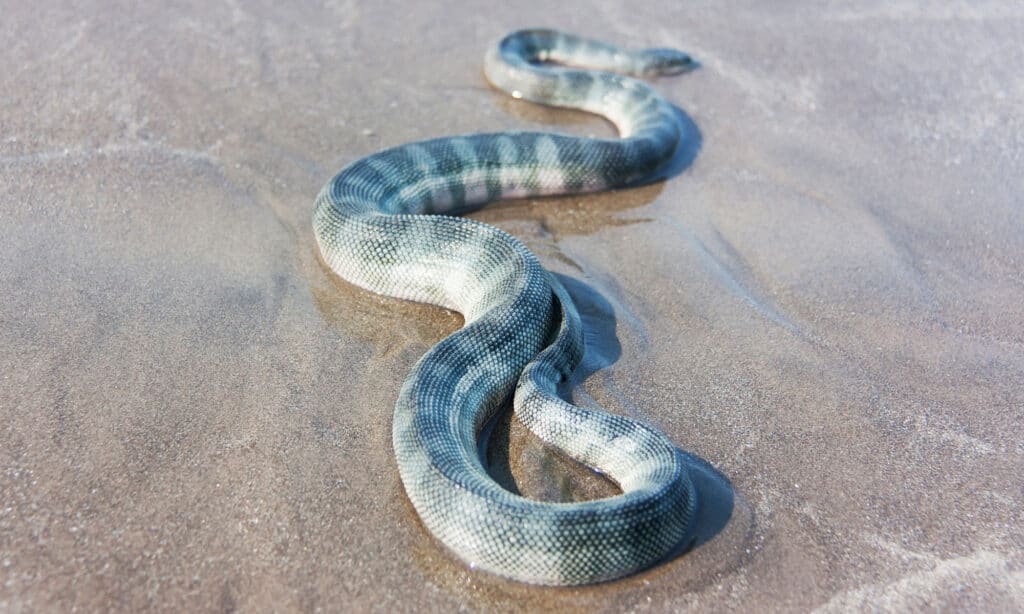
The beaked sea snake is responsible for more than 50% of all bites caused by sea snakes.
©iStock.com/Ekaterina Borisova
Beaked sea snakes are long and highly-venomous reptiles with an average length of 4.2 feet (51.2 inches). They are often colored dark gray with white sides and bellies. Also called the hook-nosed sea snake, this species is responsible for more than 50% of all bites caused by sea snakes.
Since its venom contains potent neurotoxins and myotoxins, it is responsible for about 90% of fatalities caused by sea snakes.
8. Blue-Banded Sea Snake

Blue banded sea snakes can grow up to 42 inches long.
©Bramadi Arya / CC BY-SA 4.0 – License
The blue-banded sea snake’s venom is said to be ten times more toxic than rattlesnakes’. These elapid snakes grow to a maximum length of 42 inches and have docile demeanors despite their toxic venom. They are found in the Gulf of Oman, the Persian Gulf, and the Arabian Sea.
9. Hardwicke’s Sea Snake
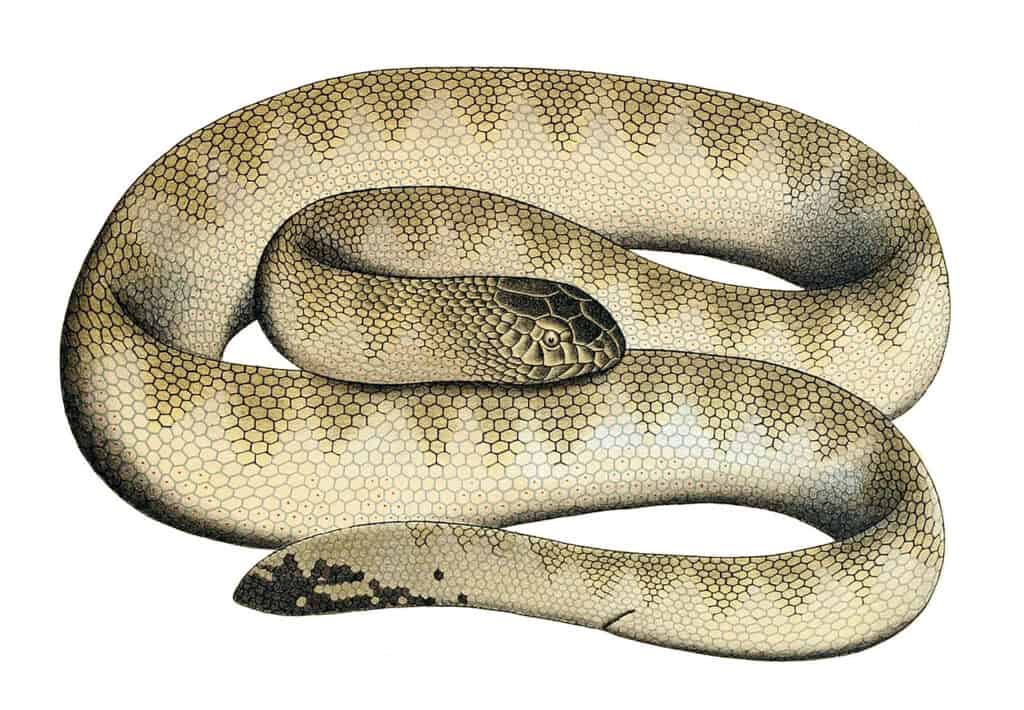
The bodies of Hardwicke’s sea snakes lack patterns.
©R. Soedirman / public domain – License
Hardwicke’s sea snake was named in honor of English naturalist Thomas Hardwicke, who collected specimens across India and had them painted by Indian artists.
Hardwicke’s sea snakes are short and stout snakes with venom capable of killing humans. They grow to average lengths of 3 feet and are often colored olive to dark gray. Their bodies lack patterns, but they may have yellow markings on their snouts.
10. Ornate Sea Snake

The bite of an ornate sea snake can be deadly.
©Tomas Kotouc/Shutterstock.com
The ornate sea snake is a venomous elapid snake that has an average length of 3 feet (36 inches). These snakes have olive-green to gray bodies and short necks. They also have dark and thick bands around their necks as well as a short and flat tail shaped like a paddle.
Their tails help them navigate the waters they live in. An ornate sea snake bite can be deadly. Its potent neurotoxic venom can lead to acute kidney failure, a coma, or death, among other complications.
11. Yellow-Bellied Sea Snake
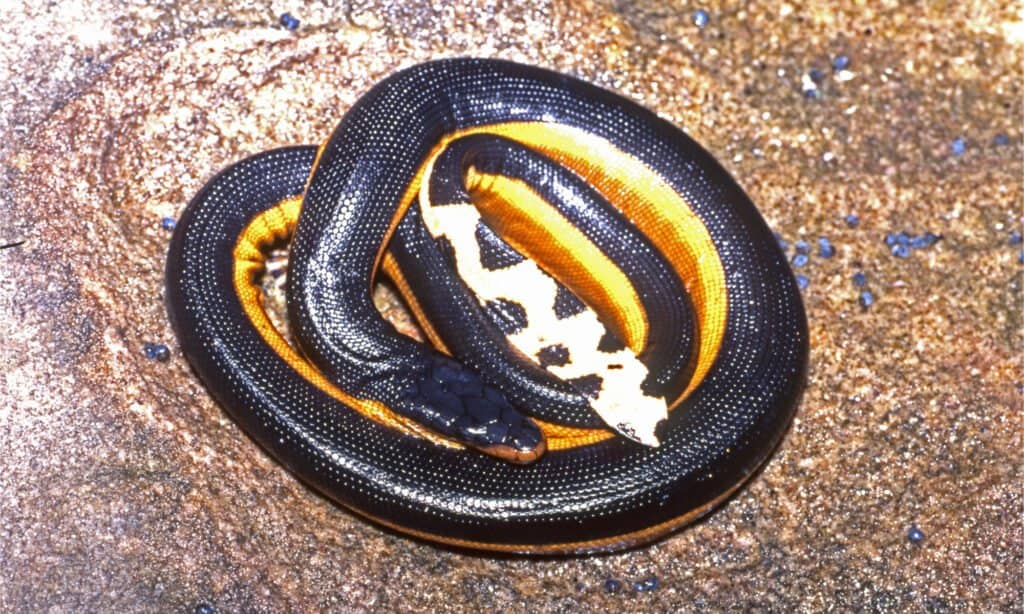
Yellow-bellied sea snakes are known for their potent neurotoxic venom.
©Ken Griffiths/Shutterstock.com
The yellow-bellied sea snake is a venomous elapid snake found in tropical waters. Yellow-bellied sea snakes are known for their potent neurotoxic venom.
These snakes have yellow bellies and brown backs, which gives them their name. One fun fact about the species is that they can take up to 33% of their oxygen requirements through their skins while swimming at the water’s surface.
12. Yellow Sea Snake
The yellow sea snake is often confused with the aforementioned yellow-bellied sea snake but is a different and unique species. Not only has its venom been studied for its anti-tumor properties, but it is also one of the longest species of sea snakes.
Yellow sea snakes are known to attain 9.8 feet (117.6 inches), although most specimens average 6.6 feet (79.2 inches). They are colored yellow or yellowish-green and have narrow black bands that start from their heads to their tails.
Summary Of 12 Snakes Of The Euphrates River
| # | Snake | |
|---|---|---|
| 1 | Levantine Viper | Average lengths of 4.9 ft |
| 2 | Desert Horned Viper | Average lengths of 1 to 2 ft |
| 3 | Persian Sand Viper | Average lengths of 1.3 to 2.3 ft |
| 4 | Radde’s Rock Viper | Maximum length of 39 inches |
| 5 | Desert Black Snake | Average lengths of 3 to 4 ft |
| 6 | Arabian Gulf Sea Snake | Average lengths of 3.6 ft |
| 7 | Beaked Sea Snake | Average lengths of 4.2 ft |
| 8 | Blue-Banded Sea Snake | Maximum length of 42 inches |
| 9 | Hardwicke’s Sea Snake | Average lengths of 3 ft |
| 10 | Ornate Sea Snake | Average length of 3 ft |
| 11 | Yellow-Bellied Sea Snake | Average length of 3.7 ft |
| 12 | Yellow Sea Snake | Average lengths of 6.6 ft |
Other Reptiles Found In The Euphrates River
The Euphrates softshell turtle, also known as the Mesopotamian turtle, is one of two giant turtles in the genus Rafetus and can be found throughout the Euphrates-Tigris River basin in countries like Turkey, Syria, and Iraq, as well as the Khuzestan Province of Iran. This endangered turtle has a smooth leathery shell that can reach up to 2.2 feet and can weigh up to 44 pounds. The Euphrates turtle prefers shallow, calm waters and can be found in the freshwater habitats of rivers, lakes, streams, ponds, and reservoirs. Thought to be a carnivore because of its previously seen feeding habits and attraction to blood, it has also been seen to plants and insects which has led to the conclusion that it is an omnivore of the opportunistic variety.
The photo featured at the top of this post is © Ken Griffiths/Shutterstock.com
Discover the "Monster" Snake 5X Bigger than an Anaconda
Every day A-Z Animals sends out some of the most incredible facts in the world from our free newsletter. Want to discover the 10 most beautiful snakes in the world, a "snake island" where you're never more than 3 feet from danger, or a "monster" snake 5X larger than an anaconda? Then sign up right now and you'll start receiving our daily newsletter absolutely free.
Thank you for reading! Have some feedback for us? Contact the AZ Animals editorial team.






